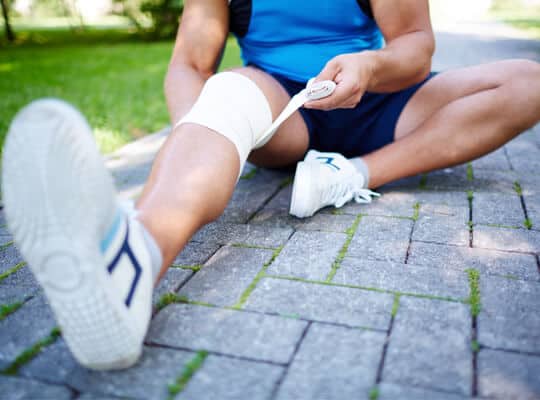Overuse Injury
Table of Contents
Overuse Injury
If you’re a runner, then you know the pain of an overuse injury. It’s that persistent nagging feeling that just won’t go away and all too often keeps us from hitting our stride on our favorite treadmill. In this post, we’ll talk about how to prevent and treat overuse injuries so that you can get back to running in no time.
Most runners know the pain of an overuse injury
Overuse injuries are common in runners. They’re often caused by repetitive stress on the body, and they can be treated with rest and strengthening exercises. Runners should also be aware of their technique, as some people put more pressure on one foot than the other when they run (which can cause pain).
To prevent overuse injuries, you should always stretch before running, warm up thoroughly before your workout, take breaks after running long distances or fast speeds for a while–and don’t forget to cool down!

Overuse injuries are caused by repetitive stress on the body
Overuse injuries are caused by repetitive stress on the body. Stress is a normal part of life, but too much stress can lead to injury. Examples of repetitive stress include:
- Repeatedly lifting heavy objects or pushing yourself beyond your physical limits.
- Repeating one specific movement over and over again, such as practicing golf swings or playing tennis every day for hours at a time without taking breaks in between games or sets (or even within games).

It’s common for overuse injuries to go undetected because they don’t have a red flag symptom, like pain or swelling
Overuse injuries can develop slowly and go undetected because they don’t have a red flag symptom, like pain or swelling. That’s why it’s important to keep an eye on your body for any signs of overuse injury.
If you have any questions about this article or would like to schedule an online appointment with our experienced doctor and talk about your pain management options, please contact us today!
If you have an overuse injury, rest is the best treatment until symptoms subside
If you have an overuse injury, rest is the best treatment until symptoms subside. The amount of time you should rest depends on how serious your injury is and how long it’s been bothering you. For example, if your knee hurts when running after a few days of doing so, it may be best to take a few weeks off from running until the pain goes away completely. On the other hand, if you’ve had chronic pain in one area for years without any improvement (such as plantar fasciitis), then it might take longer than a couple weeks before things start feeling better again after resting for several months or even years at a time!
In general though I recommend taking at least two weeks off from all forms of exercise while recovering from an overuse injury.
An anti-inflammatory medication can help relieve acute pain and swelling
Anti-inflammatory medications are a great way to relieve acute pain and swelling. Examples of over-the-counter anti-inflammatories include ibuprofen (Advil), naproxen sodium (Aleve) and aspirin. You should take these medications as directed on the label, or as prescribed by your doctor. These medications may cause side effects such as stomach upset, nausea and diarrhea if taken in excess amounts or for too long a period of time without talking with your doctor first. If you experience any serious side effects from taking an anti-inflammatory medication, contact your healthcare provider immediately for more information about how best to proceed with treatment.

Stabilizing muscles with strengthening exercises can reduce your chance of reinjury
Stabilizing muscles with strengthening exercises can reduce your chance of reinjury.
- Ankle stability: Strengthen the muscles around your ankle to help it function correctly, such as by doing ankle pumps (with or without resistance), single leg balance exercises and/or plyometric jumps. Do these exercises two to three times per week for one to two sets of 15 to 20 reps each time.
Hip strength: Strengthen hip muscles with squats and lunges while holding dumbbells at chest level or overhead; also try side lunges along with step-ups on a bench or chair if you’re feeling ambitious! Perform these exercises two times per week for one set each time; aim for 10-15 reps per exercise session
Treating and preventing overuse injuries involves taking some time off from running and strengthening your Achilles tendon and calf muscles
To treat and prevent overuse injuries, you should take some time off from running and strengthen your Achilles tendon and calf muscles. Resting will help to reduce inflammation, but if you still have pain after a few days of rest, it’s best to see a doctor for further assessment.
Stabilize muscles with strengthening exercises: Strengthening exercises can help stabilize the ankle joint so that it doesn’t move too much when you run or walk on uneven surfaces like hills or stairs. A physical therapist can help design an exercise program tailored specifically for your needs based on how much pain you’re experiencing in addition to any other symptoms (such as swelling).
Use anti-inflammatory medication: Nonsteroidal anti-inflammatory drugs (NSAIDs) such as ibuprofen can reduce pain associated with overuse injuries because they inhibit COX enzymes that cause inflammation in the body; however, these medications do not heal tissue damage caused by repetitive stress injuries like shin splints or runner’s knee–they only mask symptoms while they heal naturally on their own within three months’ time
The best way to treat and prevent overuse injuries is to take some time off from running and do some strengthening exercises. If you have any other symptoms, like pain or swelling in your Achilles tendon area, then it’s important that you seek medical care as soon as possible.
For More Information
Please do not hesitate to contact us for more information on the subject.



